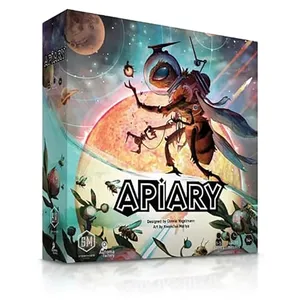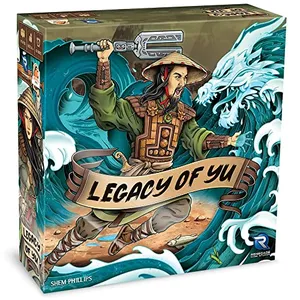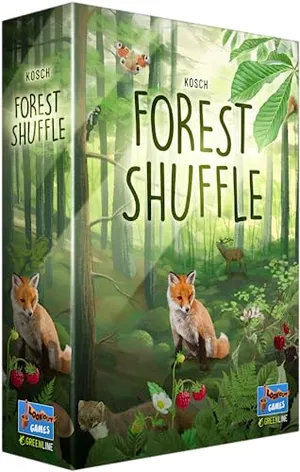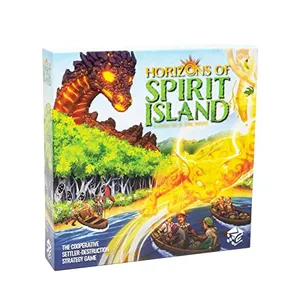The Best Board Games of 2023
In this year’s tabletop favorites, play as bees in space, Chinese emperors, fox breeders, women suffragists, fashionistas and much more
:focal(800x602:801x603)/https://tf-cmsv2-smithsonianmag-media.s3.amazonaws.com/filer_public/1d/b4/1db414fa-8aa2-461c-a978-175d3b7722dd/bestboardgames2023-v1.jpg)
It’s been another great year for board games, with pandemic-driven material shortages over and a rush of fantastic new options. Themes around sustainability and historical struggles dominated this year, and if you’re the kind of parent who insists fun be educational, options abound. But many sweet and silly new games have also debuted—as well as a lot of first-time games from new designers.
Our list this year spans price, complexity and time, with a gift for everyone, from the 6-year-old playing dress-up to the 60-year-old war-gamer. These offerings also have stunning illustrations, done by a range of diverse and talented artists.
When it comes to gaming, Dungeons and Dragons remains the 500-pound owlbear in the room, given a boost by this year’s well-received movie. It’s not strictly a board game, and its debut was long ago, so it doesn’t have its own entry, but the rush of enthusiasm for an old classic among teenagers, especially girls, has been remarkable. Scott Sprague, a gamer and parent, tells me, “I asked [my daughter] whether she wanted to talk to you for the article, but she pointed out that that would take time away from gaming.”
Keep an eye out for the new edition of D&D in 2024, but in the meantime, the nostalgic Planescape box set that seems to be a favorite of both veterans and newbies makes an excellent holiday gift for any players in your life.
For the list below, I recalled my own game-playing experiences over the past year and spoke with some of the designers of the top games to pull in their thoughts about their fellow listings.
Apiary
Good for: bee-lovers, deep thinkers
Kind of like: Lords of Waterdeep
Age: 12+
Players: 1 to 5
This charming builder-placement game featuring bees draws inspiration from a lot of sources—including creator Connie Vogelmann’s own beekeeping in her Washington, D.C. backyard. “My grandfather kept bees, and just as I was thinking about the game, I moved somewhere [where I] finally had room to do the same,” she says. Players compete to build the most impressive bee-civilization through building out their hive-ship, seeding and harvesting resources, breeding and hibernating their workers, and dancing to trade with other bees.
Apiary is Vogelmann’s first game, and it owes a lot to the community of Washington-based board game creators that’s sprung up over the last few years, she says. Like several recent games, it comes with a solitaire option using the Automa card-driven system—an innovative approach that replaces human opponents with semi-random but challenging moves by an artificial foe
“I tried to keep it close to things bees actually do,” Vogelmann says, “For instance, it didn’t make any sense for workers to block spaces [a common mechanism in similar games].” The “bump” mechanism she introduced instead is a key part of managing your workers, who grow in strength but must eventually hibernate into retirement as they get older. Balancing all the parts and points can be tricky, but it’s aided by the clear and helpful board layout that’s become emblematic of the games from Stonemaier, which published the runaway hit Wingspan.
Apiary
In a far-distant future, humans no longer inhabit Earth. The cause of their disappearance (or perhaps their demise) is unknown, but their absence left a void ready to be filled by another sentient species. Over the span of untold generations, one species of the humble honeybee evolved to fill that void.
The Fox Experiment
Good for: kids interested in science, animal fans
Kind of like: King of Tokyo
Age: 10+
Players: 1 to 4
On sale just in time for the holidays, this game by veteran designer Elizabeth Hargrave, chiefly known for her bird-collecting game Wingspan, and Jeff Fraser is themed around a famous Siberian experiment in domesticating foxes. Players roll dice every round to determine their fox’s genetic traits, trying to make the fluffiest and friendliest fox they can—and then pick which foxes become parents for the next generation. “It’s a really fun mechanism, especially for a family game,” says Apiary designer Vogelmann.
The appeal comes strongest through the beautiful cards, on which you name each fox with erasable markers. It’s a game that’s bound to delight animal-loving kids in particular, but it has enough variance and strategy to keep adults interested.
Legacy of Yu
Good for: solo gamers
Kind of like: Solitaire, Under Falling Skies
Age: 12+
Players: 1, and 1 only
Solo board games have soared in popularity in recent years, but Legacy of Yu, themed around the semi-mythological struggles of early Chinese rulers to control the country’s flooding, is an especially clever example. It’s a “firefighting” game—problems are constantly springing up, and players are trying to find the quickest and cheapest answers, while strengthening their hands for future plays. It’s also a campaign game, meaning each time you play it feeds into an overall narrative and introduces new rules and abilities. There’s a fun mix of mechanics, from placement to deck building.
Compared to brilliant, and complicated, campaign games like Sleeping Gods or Frosthaven, Legacy of Yu has a big advantage: It’s super easy to set up and tear down. The game streamlines setup to a few minutes (once you’re used to it), and each game takes about an hour. For gamers who don’t have a group handy but want an engaging and challenging experience, it’s perfect.
Legacy of Yu
Legacy of Yu is a solo-only, fully-resettable, nonlinear campaign game in which you step into the role of the legendary hero of the Xia Dynasty, Yu the Great. It will be your job to build the canals ahead of the impending flood, while also defending your growing village against neighboring barbarian tribes.
Forest Shuffle
Good for: family board game night
Kind of like: Carcassonne
Age: 10+
Players: 2-5
It’s been the hottest year on record, a depressing milestone strangely reflected in the rush of ecologically themed games, from Life of the Amazonia to Earthborne Rangers. Forest Shuffle is a family-friendly card game where players compete to build the most sustainable woodlands by using a set of 180 beautiful cards split into two images. Like similarly themed games, it advances the sustainability message with a green-friendly approach to the physical materials, eschewing plastic components entirely. “It’s super simple, takes 45 minutes and is fun, satisfying and beautiful,” says Vogelmann.
Each turn, players choose which part of the card they want to play, and they place it into the tableau on the board next to others, tucking the unused part under existing cards. They’re trying to put animals next to the environments they will thrive in and place species together that benefit each other, reflecting real science. It’s a clever mechanism that produces a stunning layout on the table that kids will enjoy—like the tangled city layouts of perennial favorite Carcassonne.
Forest Shuffle
Step into the enchanting world of the forest with the Forest Shuffle Card Game, where you'll embark on a captivating journey to create an ecological paradise right in the heart of nature. Designed for 2-4 players, this game offers a delightful experience of balancing the forest's delicate ecosystem.
Horizons of Spirit Island
Good for: alternate history readers
Kind of like: Reverse Settlers of Catan
Age: 14+
Players: 1-3
The original Spirit Island, published in 2017, is a modern classic, a game that reverses the settler mechanisms of many other games and instead puts players in the position of the magical defenders of an Indigenous community driving away Europeans. It’s also extremely complicated, especially with the (excellent) expansions—by the end of most games, taking a turn involves remembering about 12 different things at once.
Horizons of Spirit Island, published late last year as an exclusive deal with Target before expanding to wider distribution this year, strips the game down to a simpler, easier format that smart kids can pick up on more easily, but that still has the joy of the original’s nifty interactions among magical powers, the ever-growing threat of the settlers, and the island itself.
It’s also much cheaper than the full game, but it offers its own set of spirits and material that experienced players can use to supplement their existing games. Part of the fun is picking a spirit and wreaking havoc, and the options here, from Devouring Teeth Lurk Underfoot, where competitors play creatures resembling the big worms from Tremors, to Eyes Watch From the Trees, are spooky and cool.
Horizons of Spirit Island
Players are called to defend their home as Spirits of nature, fighting to defeat the colonizing Invaders that threaten to destroy their natural existence! The Invaders expand every turn, colonizing more and more of the land as they advance, their towns and cities spreading Blight wherever they’re left unchecked.
Votes for Women
Good for: historically inclined parents, war-gamers looking for a change
Kind of like: Twilight Struggle
Age: 14+
Players: 1-4, but best with 2
This complex but satisfying game recreates the struggle for women’s suffrage in America from Seneca Falls to the final passage of the 19th Amendment. One player takes the side of the suffragists, the other of their political opponents, playing cards themed around historical events and personages, from property rights to Sojourner Truth, to influence public opinion across the United States. It nicely recreates the feel of a movement; the intensity of the struggle grows over time, until, if neither side has won a clear victory, one last decisive vote.
This is a great choice for educators; the game includes copies of key historical documents from the struggle, including the 1920 edition of the New York Times after the ratification of the amendment. Publisher Kevin Bertram tells me the game “had a strong response from both college and K-12 educators, but also really resonated with people who traditionally thought only wars were good for board games.”
(A disclaimer: Of the games listed here, this is the only one I received a complimentary review copy of.)
The Fashion Game
Good for: kids and adults with an interest in cute fashion.
Kind of like: playing dress-up
Age: 6+
Players: 3-6
In this independent Japanese game (with instructions in both Japanese and English), players compete to create the cutest or most striking outfits, using the colorful clothes and accessories provided in the box, and take turns as the “editor” of a fashion magazine to judge them.
Independent designer Ryoko Yabuchi, a mother of two who works in video games in her day job, set out to make games that can be played “with kids, at a girls’ night out or with relatives at home.” She succeeded with aplomb with both this and her dexterity-based game Yura Yura Penguin.
“I’ve played [the Fashion Game] with my 9-year-old daughter, my 4-year-old niece and my 75-year-old mother,” says British game designer Chris Longhurst. “The 4-year-old did need the cards read to her but otherwise got it just fine.” Unless you live in Japan, you’ll need to get this one from the designer’s website, which ships internationally.
Land and Freedom
Good for: left-wingers, people annoyed by left-wingers
Kind of like: Churchill
Age: 13+
Players: 3
Three-player games have often been a tricky spot for designers, who tend to gravitate to either competitive two-player games or cooperative four-player games. This game, based on the Spanish Civil War, takes that tension and forges a game that’s halfway between competitive and cooperative. Each player represents one of the Republican factions of the Spanish Civil War: the Moderates, Communists and Anarchists.
Using historically inspired cards, the goal is to cooperate to defeat the Nationalists—while at the same time struggling for power to give yourself control of the government after the war. “There can only be one winner, so the players are also knifing each other in the back,” says Bertram.
Trying to fight against fascism while contending with the people on your own side might be a little too real for some gamers in America today, but this game is tense, tricky and potentially friendship-ending—if, for instance, your buddy steals all your gold and sends it to the Soviet Union.
A Note to our Readers
Smithsonian magazine participates in affiliate link advertising programs. If you purchase an item through these links, we receive a commission.



